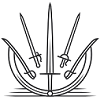Tournament participants must follow the directions of the tournament director and staff at all times. Any participant exhibiting behavior that places themselves or others at risk of harm will result in immediate disqualification and possible intervention by local law enforcement.
Tournament Goals
The goal of the Helsinki Longsword Open cutting tournaments is to:
- Showcase/evaluate/reward sword skills that canot be tested in a sparring environment.
- Promote an integrated training regiment, with good cutting mechanics in sparring and good fencing behavior in cutting
- Be creative, educational, and enjoyable for both participants and spectators.
Safety Regulations
All competitors will be required to assume proper safe-handling procedures for sharp swords. This includes, but is not limited to, swinging the sword when there is the possibility of others in the vicinity, losing control of the weapon, or approaching the cutting area before being explicitly instructed to do so by the tournament staff. Should the tournament officials perceive that there is any safety issue, they retain the right to remove individuals from the cutting tournament or cutting qualifiers at their discretion.
Competitors are forbidden to cut toward their lead leg with Descending Cuts in Round 1
(Competitors in Rounds 2 and beyond may cut towards their lead leg.)
Round Descriptions
Round 1 - Basic Cuts
(In round 1 you may not cut towards your lead leg.)
Target 1 - Oberhau (single tatami roll)
Competitors will perform 3 descending cuts on each side, in any order. (6 total cuts)
Target 2 - Unterhau (single tatami roll)
Competitors will perform 2 ascending cuts on each side, in any order. (4 total cuts) Should the cut succeed the competitor may attempt a cut back along the previous line with a descending cut for bonus points — provided they do not re-chamber the sword between cuts.
Target 3 - Slow Lightning Cut (hanging paper)
Competitors will perform 2 lightning cuts, 1 on each side. They are permitted to wait up to 5 seconds for the paper to settle down between cuts, but must wait stationary in the ending position of their previous cut.
Example ↓

Lighting cut along one diagonal.
Top 10 by score will advance to the next round
Round 2 - Reactive Cutting
Target 1 & Target 2 (single tatami roll)
The cut and target will be signaled to the competitor, and they will have 7 seconds to advance to the target, complete, and return to the starting area.
Example ↓

Cut the mat and angle indicated.
Eligible cuts:
Top 4 by cumulative score advance to Round 3
Round 3 - Cutting Feats
Counter-Rotation Cutting (single tatami roll)
Competitor will perform 6 cuts on a target using a “counter-rotation” mechanic. They are free to use whatever stance/footwork they wish, however a movement of the front or rear foot during the cut must show the counter rotation.
(A full step isn’t required, but the movement of the foot should clearly show the counter-rotation.)
Example ↓

Counter rotation may be performed by front or rear foot.
Competitors will be able to choose any of the following for their 6 cuts:
- Right Descending
- Left Descending
- Right Ascending
- Left Ascending
- Right Zwerhau
- Left Zwerhau
The highest point value for each cut will be taken. (example: You can retry your Left Oberhau 3 times to get one without a deduction, but then you would only get to try 3 other cuts.)
Paper Cutting - With Feder (hanging paper)
Competitors will have 80 seconds to perform as many different cuts as possible on a hanging roll of paper. The same cut can be attempted/repeated as many times as the competitor wishes, with the final round score being the sum of:
- The highest point value achieved for each cut.
- The second highest point value for each cut divided by two.
- The third highest point value for each cut divided by four.
Eligible cuts: L/R descending, L/R ascending, L/R zwer.
Competitors will roll down their own paper in between cuts. The clock does not stop for this action.
Parry+Cut+Parry (single tatami roll)
Competitor will stand in front of a tatami mat, with the feeder standing behind the mat with a long wooden staff. The competitor will signal for a cut to be thrown along one of the four diagonals, and the staff will be swung along the line indicated.
The competitor must parry the staff, and then respond with a cut of their own on to the tatami mat. This must be done in a fluid motion with no transition delay. While the competitor is completing their cut the staff will be pulled back, and will cut back along the same line to be parried again.
Competitors will perform 4 cuts. The order is up to the competitor, but they must parry once along each of the four diagonals, and cut once along each of the diagonals. It is up to the competitor to pick what order they wish to be fed the strikes, and in which direction they want to cut after the parry.
Example ↓

Cut direction does not have to match parry direction.
Final tournament placings are cumulative based on all round scores.
Quality Standards
Base Point Value: A cut with no deductions will be awarded 10 points.
Deductions: Any of the following will deduct from the final score. In the event that multiple infractions are recorded, only the highest value will be applied.
Tatami Deductions
Cut Form
'x' indicates that no points will be awarded.
- [-2]: Stepping ahead of cut Example ↓
If the lead foot is firmly plated while the sword is being chambered/accelerated.
- [-5]: Expose Back Example ↓
The exposes the full side/back while completing the cut.
- [-5]: Entering Waiting Area as Signal Period Ends* Example ↓
Reactive cutting round only.
- [X]: Not In Waiting Area When Signal Period Ends* Example ↓
Reactive cutting round only.
- [X]: Leaving Waiting Area Ahead of Signal* Example ↓
Reactive cutting round only.
- [+2]: Facing Forward (Bonus Points!) Example ↓
If the hips/body are still forward facing during and after the motion. aka: the final position looks like it's something you would see in sparring.
Cut Quality
'x' indicates that no points will be awarded.
- [-5]: Small Mountain Example ↓
A mountain is when a cut intersects a previous cut or cut attempt. This is penalized because the competitor no longer needs to cut through the full width of the target, and also because it demonstrates poor targeting and control. Small mountains will be assessed a point deduction of -5 points.

- [-5]: Tatami Landing Distance (yellow) Example ↓
- [X]: Tatami Landing Distance (red) Example ↓
‘Landing Zones’ will be used to assess cutting quality. These zones will be clearly marked on the ground around each cutting stand.

- The zone deduction is assessed based on the position at which the tatami first comes into contact with the ground (i.e. rolling after contact does not impact the score).
- In the event that a clearly defined piece cannot be identified, the cut will be assumed to have landed in the red zone.
- Should a cut spray debris, it will be assumed to have landed in the red zone.
- Should a piece land straddling two zones, it will be assessed as landing in the lower deduction zone.
- [X] Scallop Example ↓
A scallop is defined as a cut which clearly curves its trajectory in the tatami mat. This also applies to any parallel mat cuts which do not have the two cuts in the same line.

- [X] Large Mountain Example ↓
A mountain is when a cut intersects a previous cut or cut attempt. This is penalized because the competitor no longer needs to cut through the full width of the target, and also because it demonstrates poor targeting and control. Cuts with mountains of greater than 1” (25.4 mm) will be awarded no points.

- [X] Tatami Surface Not In Line With Cutting Plane Example ↓
This is a phenomenon that can occur with extremely sharp swords which are highly optimized for cutting. If the tatami ends up cut on a different plane than the one on which the sword was swung, it indicates that the competitor performed a ‘failed’ cut, but that their sword was able to overcome this and still pass through the thin tatami targets.

- [X] Cut Below Limit Example ↓
The lowest rubber band on the tatami mat will indicate the lowest height a competitor may cut at. Any cuts that pass below this line will receive no points. Should the competitor hit the stand or floor, they will receive no points for the cut and instead have a value of -10 applied to their overall score.

- [X] Failed Cut
- [X] Wrong Cut
Paper Deductions
Paper cutting will be performed on a vertical hanging paper. This is construction paper, and the difficulty of this is expected to be similar in difficulty to cutting a tatami mat. (The paper offers lower resistance, but can rip more easily and tests for a much larger cutting line.)
'x' indicates that no points will be awarded.
- [-2]: Roughness Example ↓

- [-5]: Small Rip Example ↓

- [-5]: Small Scallop Example ↓

- [-5]: Sound of impact or strong paper flutter
- [X]: Ripped Paper Example ↓

- [X]: Large Scallop Example ↓

Competitor Conduct
Competitors shall not begin cutting until instructed to do so by the tournament staff. Following the completion of each cut, the competitor must wait for confirmation from the cutting judges before beginning their next cut. After assessing the quality of a cut, the cutting judges will hold up a color-coded card to provide feedback to the cutter and the audience and to indicate that the competitor may make their next cut. A competitor may not address the table to inquire about a score which has been awarded. These cards will be:
- Green - No point deduction on cut
- Yellow - Point deduction on cut
- Red - No points awarded on cut
- Verbal Warning - Penalty assessed
Should a competitor request a mat straightening (provided the round allows for it), they must first step out of the cutting area with the tip of their sword pointed toward the ground. The competitor must not move until instructed to do so by the tournament staff.
Competitors that take excessive time to begin after they have been signaled to cut will be warned by the tournament staff, and may be subject to penalties if there are repeated infractions. While it is not necessary for a competitor to rush after they are prompted, it is intended that they perform the cut in a short period of time without spending considerable time ‘fidgeting’ or ‘psyching themselves up.’
During reactive cutting rounds, the competitor must wait in an area designated by the tournament staff. Only once the cut has been signaled may they move forward and execute their cut. The competitor must then return to the waiting area before the signaling period has concluded or be assessed a point deduction on the cut.
Equipment
All competitors will use the Albion Earl longsword provided by the tournament.

